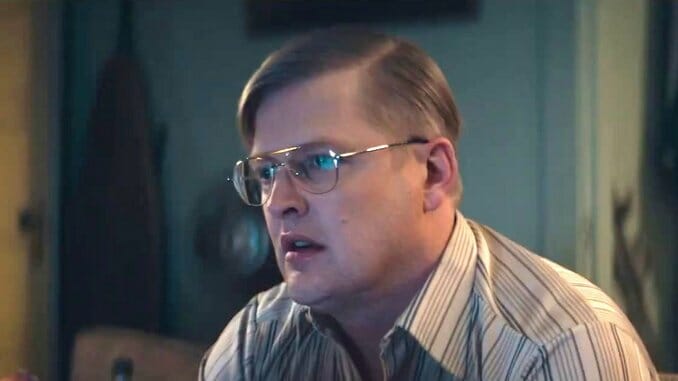
Swiping left and right on Tinder sounds like a drag, but imagine VHS tapes being the sole available option for finding a soulmate without going old school and meeting people in person. Jon Stevenson’s Rent-A-Pal makes the process look nightmarish, and that’s before Wil Wheaton’s Andy starts reciting the ur-text of MRA talking points. Wheaton is the film’s first exceptional element. The second is Stevenson’s restraint. This movie isn’t about online dating or video dating, even though the narrative focuses on the function video dating services played in the lives of the lonely in the 1980s and ’90s. It’s about the viral spread of entitled white male grievance, filtered through horror’s lens.
Wheaton has first billing on Rent-A-Pal, but Brian Landis Folkins is Stevenson’s protagonist, David, who lives at home with his mom, Lucille (Kathleen Brady). Lucille suffers from dementia. David, ever the dutiful son, doesn’t work—he and Lucille are able to comfortably live off her social security, if only just—and spends his days looking after her: He feeds her, clothes her, tucks her in, keeps her safe, and in one particularly sweet moment, watches His Girl Friday with her, sending her a loving glance from the corner of his eye. It’s the rare occasion on which his mom registers as his mom. The rest of the time David has to remind her that he’s her son and not her late husband, 10 years gone via suicide. His burden is heavy. He carries it as best he can.
But loneliness is a poison, so David relies on a dating service to find romance that never comes. Then he notices a tape at the front desk, “Rent-A-Pal,” and he decides to give it a shot. The tape’s host, Andy, charms immediately. He’s genial and disarming, a squeaky-clean, aw-shucks kind of chap, earnest to a fault. Of course Andy cares about the schmucks who rent his tape. He’s the captive audience of his own captive audience. David finds the set up weird to start, but succumbing to isolation, grows to rely on Andy’s camaraderie more and more, even as it becomes clear that whoever or whatever Andy is, he’s bad news.
This undersells the danger Andy represents for David, who has lived for too long with neither male role models nor friendships and is especially vulnerable to the suggestion that he deserves a buddy to confide in. In this case the buddy wears a uniform designed to lower one’s guard: sweater vest, a tie secured with a tight Windsor, khakis, and of course an unwavering smile. Anybody would open up to Andy after a short, awkward introduction. Stevenson doesn’t explicitly ask the film’s obvious follow-up question, but curious viewers may wonder how many Davids came before David. Given Rent-A-Pal’s thesis about the psychology of white patriarchal ideation and its seductive power, a deeper exploration is unnecessary. That animus is highly transmissible. It’s plain as day in American culture now as it was 30 to 40 years ago.
Stevenson drains the color out of Rent-A-Pal to give his images the impression of being barren. David’s existence is solitary, mundane and repetitive, cast against the backdrop of an unidentified midwestern state that seems to always be caught in winter’s grip. With Andy alive and on screen, the film gains a level of seductive warmth: Not only is the video a ticket to much-needed guy time, it’s also an escape from the cold drudgery of David’s routine. Andy’s too-good-to-be-trueness coupled with his creepy affability are readily ignored under the circumstances. Nothing about either the tape or Andy strikes David as the slightest bit sinister, even when the TV turns itself on early in the film and Stevenson’s capture Andy’s face leering through the screen over David’s shoulder as the unaware sap organizes his VHS collection. There’s much he’s willing to overlook to cure his need for companionship. When he does match up with another of the dating service’s clients, Lisa (Amy Rutledge), Stevenson shows how advice and encouragement sound totally different depending on who’s offering them—there’s Lisa, speaking with compassion and Andy, addressing David’s ego. It’s a quiet battle of wills fought over his soul.
Throughout Rent-A-Pal, the language of misogyny bleats loudly, persuading the easily gulled that only their fellow Y chromosome compatriots understand them and that the roadblock denying them fulfillment is female influence. Considering the text and subtext, the tone of the film is a much less pissed-off than one might expect. Stevenson plays the horror of the scenario with eerily paced efficacy, but he builds that horror on a somber tragedy. Problems with privileged and self-aggrieved white masculinity are not new to 2020. They were not new to 1990, either. But Rent-A-Pal doesn’t treat the dynamic between Andy and Dave as a contemporary invention. Instead, it serves as a historical document, tracking the history of how one white man’s animus can push another man off the edge of reason. Wheaton’s terrifying performance reminds us that people like Andy are best avoided. When the chips are down, they won’t have your back. They’ll just ram a knife in it.
Director: Jon Stevenson
Writer: Jon Stevenson
Starring: Brian Landis Folkins, Wil Wheaton, Amy Rutledge, Kathleen Brady
Release Date: September 11, 2020
Bostonian culture journalist Andy Crump covers the movies, beer, music, and being a dad for way too many outlets, perhaps even yours. He has contributed to Paste since 2013. You can follow him on Twitter and find his collected work at his personal blog. He’s composed of roughly 65% craft beer.